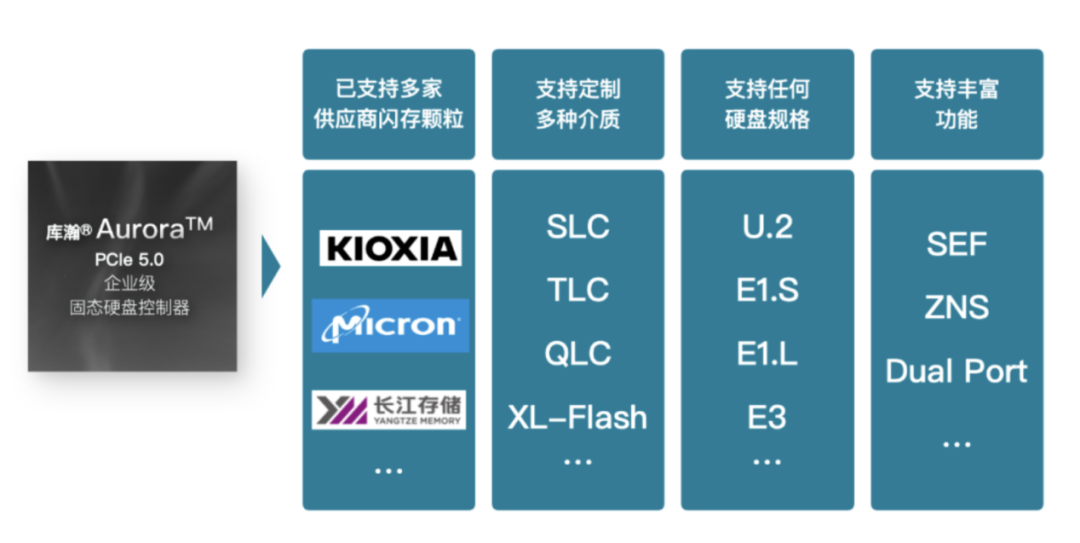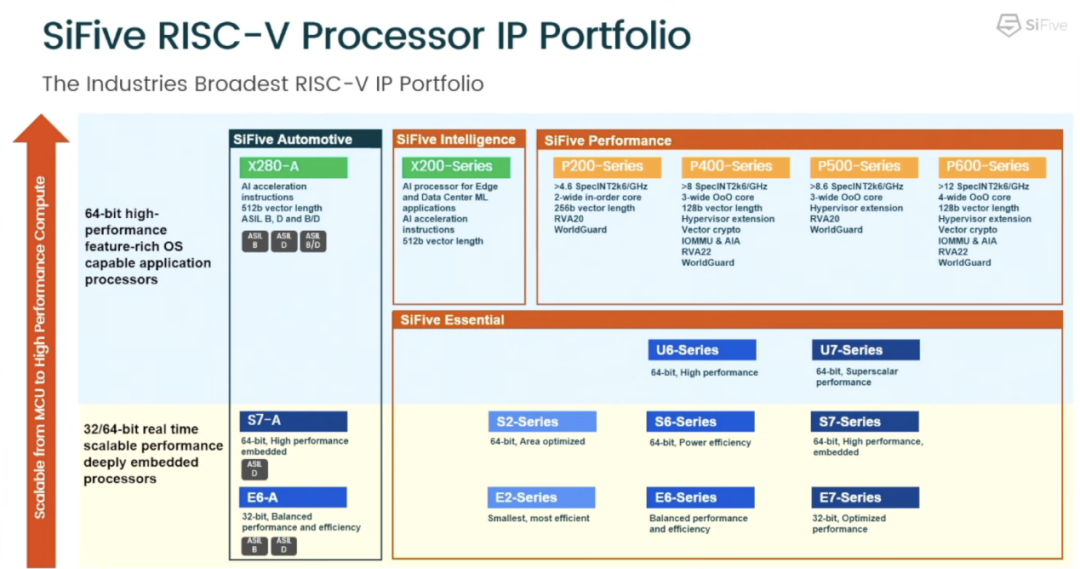The report from Electronic Enthusiasts Network (by Zhou Kaiyang) states that eight years ago, RISC-V emerged, and for the first three years, it seemed to be an unnoticed ISA. Today, it is regarded as the preferred architecture by many chip design companies. Thanks to the ecological development and technological accumulation over the past eight years, RISC-V has begun to appear in various applications within the semiconductor market, and the RISC-V of last year and this year has initiated a new round of expansion. In addition to common applications in consumer electronics and industrial control, which are rapidly scaling, and areas like AI and HPC where new architectures can easily take root, RISC-V has already started the process of radiating to more applications.
Accelerating Mechanical Hard Drives and Supporting High-Performance Enterprise SSDs
With the explosive growth of data in enterprises and data centers, statistics indicate that by 2026, the total amount of data will reach 221 Zettabytes. The majority is no longer offline cold data; in the current era of popular recommendation algorithms and generative AI, online hot data that needs to be frequently accessed by computing nodes has become the main focus. Consequently, many storage manufacturers are considering designing higher-performance chips to meet the growing demand for storage performance.For example, Seagate has been using a relatively simple self-developed ISA CPU for many years. In 2015, while developing compiler support for this CPU, they discovered RISC-V and decided to develop a new CPU based on RISC-V. The new CPU design offers ultra-high real-time processing performance and was quickly utilized in Seagate’s mechanical hard drives to implement more advanced control algorithms for hard drive motors. For instance, the MACH.2 mechanical hard drive, which uses multiple read/write arms, has a multi-drive system design that doubles its IOPS performance.After being applied in mechanical hard drives, RISC-V quickly extended to solid-state drives. Last year, Phison released the next-generation PCIe Gen4x4 customizable enterprise SSD solution platform X1, and Seagate leveraged this platform to launch the Nytro 5050 series SSD. On the main control PS5020-E20 used in X1, Phison employed the N25F RISC-V core from Andes Technology. The N25F features a 5-stage pipeline design, and with the ACE framework provided by Andes Technology, it offers greater flexibility for customized dedicated instructions, making this core very popular in the embedded controller market.

KUHAN Aurora Main Control / Kuhan TechnologyIn addition to PCIe 4.0 SSD controllers, domestic companies have also launched PCIe 5.0 SSD controllers based on RISC-V, such as the KUHAN Aurora chip from Kuhan Technology. This chip is an enterprise-level PCIe 5.0×4, NVMe 2.0 solid-state drive controller chip, supporting a maximum capacity of 32TB. In terms of read and write performance, Aurora can achieve a reading speed of 14,000MB/s and a writing speed of 10,000MB/s. Additionally, Kuhan Technology has developed a storage server-specific processor chip (SPU) based on the RISC-V architecture to replace traditional CPU cores in storage server controllers, efficiently managing different storage media such as SCM, SSD, and HDD.
From Automotive MCUs to ADAS
In fact, RISC-V began to explore the automotive chip field two years ago, although there were not many automotive-grade chips available at that time, and very few were mass-produced. However, as design processes improve and design tools and AI automotive certifications are completed, car manufacturers are increasingly willing to break away from architecture/supplier binding and shift towards software-defined solutions, making RISC-V’s entry into the automotive sector imminent. For instance, the Mobileye EyeQ Ultra chip, which is set to release engineering samples by the end of this year and plans for mass production in 2025, or the Renesas RH850/U2B MCU, which has already shipped and is primarily used for Zone/Domain control ECUs and ICE, TCU, etc.

SiFive RISC-V Processor IP Product Line / SiFiveTaking SiFive as an example, after Patrick Little, a former executive who successfully expanded Qualcomm’s automotive market, became CEO of SiFive, the company has shifted more focus to AI and automotive fields, especially concentrating on automotive chip IP this year. From the automotive IP lineup already announced, the first to be released is the E6-A series for automotive MCUs and system controllers, which not only meets ASIL automotive standards but also supports common functional safety redundancy designs such as dual-core lockstep.Next is the X280 automotive variant X280-A series, which will be launched this year, focusing on vector operations. This series emphasizes stronger AI computing power while also supporting features like dual-core lockstep and DCLS. Even though it has performance comparable to the X280, SiFive does not position the X280-A for direct use in ADAS, IVI, or central gateways, but rather for onboard vision or sensor fusion computing applications. However, SiFive is already planning a more powerful automotive RISC-V IP product series, and it is believed that soon it will complete its IP layout in the automotive field.Finally, the S7-A, which will be launched next year, balances real-time performance and high performance. SiFive states that this IP is more suitable for high-performance safety island designs in automotive SoCs, as such applications require support for low-latency terminals while also having 64-bit memory space visibility like other mainstream application processors. For this reason, SiFive currently only offers ASIL-D functional safety level options for the S7-A.
From IoT to Commercial Communication
Most people are unaware that, in addition to IoT communication chips like Wi-Fi and Bluetooth, RISC-V has also entered the more mature commercial fields of 5G and cellular communication. Recently, we introduced several domestic manufacturers that released RISC-V Cat.1 chips, and in the 5G base station chip sector, RISC-V has also made inroads. For example, the PC802 chip launched by domestic manufacturer Bikoqi is specifically designed for standards like Open RAN and is a 4G/5G small base station baseband SoC.

Bikoqi PC802 Chip / BikoqiThe PC802 is designed based on the CEVA XC12 vector signal processor and Andes Technology’s N25F scalar RISC-V processor, supporting both R15 and R16 versions of 3GPP 5GNR, as well as dual-mode 5GNR/LTE, and can handle two physical layers separately or process them simultaneously on a single chip, making it very suitable for developing dual-mode small base stations for 4G and 5G. As 5G small base stations enter a period of scale growth, baseband chips like the PC802 are bound to gain more market opportunities in large-scale procurement by operators.EdgeQ is also making strides in this application scenario, with their 5G on-chip base station solution utilizing RISC-V for 5G signal processing, integrating an 8-core Arm Neoverse CPU and NPU as a subsystem. The signal processing part consists of multiple RISC-V scalar cores, each with multi-stage pipelined computation units, supporting 50 custom extensions/instructions, including FFT and composite modulation. EdgeQ has already begun collaborating with manufacturers like MaxLinear to develop integrated 5G small base station designs.
Conclusion
Despite this, RISC-V still has many applications that have not yet been covered. For instance, while there are already many products based on RISC-V AI chips, GPUs based on this architecture have yet to appear, and RISC-V chips still lack capabilities in advanced graphics processing, so most RISC-V SoCs can only choose to integrate Imagination’s GPU IP.Furthermore, chips for high-end consumer electronics, such as high-performance mobile phones or laptop processors, also face shortcomings in hardware performance and software adaptation. Some pioneers have begun to lay out plans, but significant ecological cooperation and innovation are still needed to potentially take market share from Arm and x86.



Disclaimer: This article is original from Electronic Enthusiasts Network, please indicate the source above when reprinting. For group communication, please add WeChat elecfans999, for submission, interview requests, please send an email to [email protected].
More Hot Articles to Read
-
Elon Musk predicts that the number of robots will exceed humans; are humanoid robots the future of smart homes?
-
The crazy price war in the automotive industry! Is the industry self-consistent or will it drop to the bottom? Let the bullets fly for a while.
-
Exploring the application of large models has become the current main theme! Many vertical field large models are being released!
-
Renesas signs a ten-year deal with Wolfspeed; 8-inch silicon carbide becomes a battleground.
-
NVIDIA, Microsoft, Amazon, and others are queuing up to purchase SK Hynix HBM chips; these domestic equipment manufacturers are seizing opportunities.